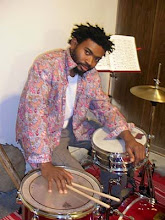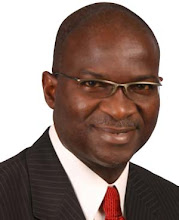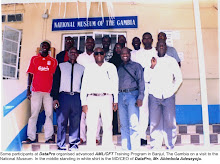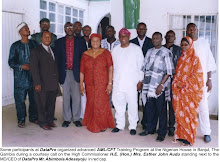Contra-Bassist Bright comes alive with Rhythm and Grooves.
Adedayo Adejobi
Bright Gain is one name that does not readily ring a bell in the circular world, but jazz enthusiasts would really attest to his nimble fingers, fast paced sound and dexterity on the bass guitar
Mentioning and acknowledging relevant and notable names of highly revered, though now internationally relocated and recognized Jazz Instrumentalists, profiles of people like Fela’s lead saxophonist, Seyi clegg, renowned pianist and producer Sola Raji formerly with Jazz Diva, Yinka Davies, Texas based Pianist and internationally acclaimed producer Dapo Torimiro of the now defunct KUSH group, Wole Oni, Nigeria’s first contemporary jazz drummer, Ray Jehovy, Jazz guitarist and Agboola Shadare amongst a very competitive few readily come to mind. . Nigeria’s fastest most experienced and widely read Contra-bassit whose name readily matches the above list and still stands very relevant in Nigeria’s present jazz history is a jazz lover’s delight.
Since arriving Lagos in 1995, Lagos based Nigeria’s best Bass player, jazz composer and promoter Bright Gain has been a force to be reckoned with. Born Sagbamah Bright Gain in 1973, Bright Gain has performed and recorded with numerous Artiste such as international flutist and philharmonic composer, Tee Mac Omatsola Iseli, Jazz Vocalist and composer ,Yinka Davies, French pianist, Manuk Hanchadrurian, Greek guitarist Sotiris Papadopoulos, e.t.c. As a jazz promoter, Bright Gain has organized different classic jazz programs attended by very important dignitaries like ”Jazzmind Jazz Fest" at the Muson Center in 2004, ”Jazify the Lord with Bright Gain “a quarterly jazz program. An award winning Jazz Artiste CMA Jazz Artiste of the year 2006.
Bright who plays the bass, a lead, melody playing instrument with dexterity is influenced stylistically by various samples of Smooth jazz, contemporary jazz R&B, funk and pop has had great success balancing the artistic with the commercial especially in Nigeria where jazz appreciation was terrible, though fast emerging and spreading quickly now as the genre is witnessing the much needed patronage it so deserves.
Sagbamah, Nigeria’s most revered fastest and most experienced jazz bass player, a master of the hollow body instrument in a recently concluded Muson concert Jazz Festival performed slow tempo ballads and walking basslines with three fingers while he used the more nimble tips of the fingers to play fast-moving solo passages and pluck lightly for quiet tunes. He seems to have mastered the use of amplifications as he could accentuate and de- accentuates certain bass frequencies responsiveness such that there was less finger noise.
Bright Gain, whose use of the technique was often highly syncopated and virtuosic, sometimes interpolated two, three, four, or more slaps in between notes of the bass line. He played rapid, syncopated and rhythmic bass lines in coordination with the drummer who played heavy groove. In his song titled ‘‘Lily’s Song’’, the bass guitarist played a more lengthy expansive and improvised solo role with a few short bass breaks during the concert. Also while performing other songs he made regular use of the upper notes of the chord, 9ths 11ths 13ths. The semitone approach to the chord note from above in addition to the lead from below. This, of course, led to chromatic chord movements in the harmonies, complicating the sequence but supplying smooth forward momentum appealing to the hear and the discerning mind. The phrasing was 'jagged' and 'angular' and full of fast triplets and sixteenths, the melodic line was spiced with unexpected accents.
Bright who plays the original customized modern six strings 24 frets Fender bass plays same with a distinct sound because the string buzzes against the wood and is somewhat muted because the sounding portion of the string is in direct contact with the flesh of the player's finger.
The bass allows players to use the expressive devices of glissando, vibrato and microtonal intonations such as quarter tones and just intonation in performances, according to the type of material he’s performing.
Looking through Gain’s previous work, there seems to be a process of coming to terms, a personal journey. In evidence, given the stylings of his previous albums, Stranger On The Sofa (2006) seems, in comparison, even given it’s moments of introspection, more documentary, more detached and lighter in it’s tone.
Yeah, I think I’ve sort of settled a few of my demons... wrestling with demons. I think I decided to take them out for a drink. Therefore I’m a lucky lad, I think, because you don’t really get the chance to do that kind of work in music. I think that’s saved for other areas of art, like abstract painting. People go like “That’s a guy with issues” and then they go off. But I made this the genre I wanted to work in and I was able to put things out that for me meant a certain coming to terms with and a certain putting things to sleep. I think Stranger is the beginning of a kind of work that, still, with an ironic eye, I hope, warms to the world.
Most jazz bassists specialize in either the double bass or the electric bass; in some cases, though, performers achieve a high level of virtuosity on both instruments, But for Sagbama Bright Gain whether accompanying or soloing, or playing on a double bass or an electric bass he usually aims to create a rhythmic drive and "time feel" that creates a sense of "swing" and "groove".
Because an unamplified double bass is generally the quietest instrument in a jazz band, many players like Bright as he is popularly called in the Jazz circle use the traditional slap style, a vigorous playing technique which involves slapping and pulling the strings so that they make a rhythmic "slap" sound against the fingerboard between the main notes of the bassline producing a snare drum-like percussive sound. The slap style cuts through the sound of a band better than simply plucking the strings, and allows the bass to be more easily heard, thus creating a stronger and solid tone.
Also speaking on the public perception on Nigerians towards jazz’ although many jazz listeners group smooth and contemporary jazz together, the genres are slightly different. Smooth jazz is generally considered background music played in bars in order to create an enticing late-night, non-alcoholic social atmosphere where conversation is encouraged. Whereas "straight-ahead" contemporary jazz is seen as demanding the listener's undivided attention.’’ Sagbamah said.
Sabgamah blames the decline in popularity of the smooth jazz format on a variety of factors, including lack of compelling new music, over-reliance on instrumental cover versions of pop songs similar to the mostly patronised reports showing lower ratings returns for smooth jazz stations than the traditional diary system had. Lack of revenue and the genre not being viable during the current economic crisis have also been cited as reasons. Sagbamah,a purist of the format also feels that the smooth jazz interpretation has strayed too far from its roots in contemporary jazz and new age music by over-relying on soft urban vocals, with R&B artists such as Beyonce Knowles and Aretha Franklin now staples of many smooth-jazz playlists.
Though the jazz genre is less common in Nigeria, possibly due to a relative lack of high profile mainstream jazz artists, while he also said new and innovative jazz musical works released by Nigerian jazz players has largely failed to gain airplay. He also noted that jazz until now did lack funding while other genres receive sponsorship.
Bass playing for Bright goes beyond hitting the notes, but he defines same by the instrumental approach to the voice, where he ‘‘the singer’’ matches the instruments in their stylistic approach to the lyrics, improvised or otherwise, or through scat singing. This according to bright the use of nonsensical meaningless non-morphemic syllables to imitate the sound of instruments. ‘’I don't feel like I'm singing, I feel like I'm playing the bass’’. He noted.
Compared to other great jazz players who scat- sing, Sagbama has an expansive vocal range that can hit any octave. Where Sagbama's genius lay, however, was his impeccable timing, nuanced phrasing, and emotional immediacy, qualities admired by myriad jazz lovers.
Being a producer- making a remarkable album that proceeded to win him an award for making the “ Jazz Record Of The Year”2006, probably attributable to the close relationship between his singing style and his bass playing- melodic and chromatically fluent, with a touch of blues influence, the emphasis on sensuous, soft vocal lines. which stand to date as significant developments in the field of fusion jazz in Nigeria. Bright’s approach to Vocal Jazz included Latin Jazz, using a ‘percussive’ element in his work. Gain has the remarkable ability to turn concerts into large-scale ‘workshops’, where the audience plays an integral role.
Describing his music, Bright says “I really like when people kick up their heels and go crazy.”
Bright who leads his jazz band comprising of Pianist Ini Ukoh and drummer John Osadolor combine Jazz, Rhythm and blues, gospel and soul arrangements, thus setting the standard for contemporary jazz contemporary groups in Nigeria. He also focuses on more ‘percussive’ elements in their music, going as far as to create ‘vocally produced bluesy vibrato instrumental jazz’ on a whim.
Sagbama, who, aside from performing, give jazz clinics at schools and universities.
Thursday, January 21, 2010
Subscribe to:
Posts (Atom)















